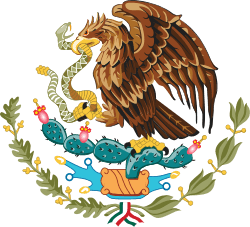Mexican miracle
Part of a series on the |
|---|
| History of Mexico |
 |
|
Spanish rule |
|
1864–1928 |
| Timeline |
| Mexico portal |
The Mexican miracle refers to the country's inward-looking development strategy that produced sustained economic growth of 3 to 4 percent and modest 3 percent inflation annually from the 1940s until the 1970s.
Mexican miracle
Background
This growth was sustained by the government's increasing commitment to primary education for the general population from the late 1920s through the 1940s. The enrollment rates of the country's youth increased threefold during this period;[1] consequently when this generation was employed by the 1940s their economic output was more productive.
Additionally, the government fostered the development of consumer goods industries directed toward domestic markets by imposing high protective tariffs and other barriers to imports. The share of imports subject to licensing requirements rose from 28 percent in 1956 to an average of more than 60 percent during the 1960s and about 70 percent in the 1970s. Industry accounted for 22 percent of total output in 1950, 24 percent in 1960, and 29 percent in 1970. The share of total output arising from agriculture and other primary activities declined during the same period, while services stayed constant.
The government promoted industrial expansion through public investment in agricultural, energy, and transportation infrastructure. Cities grew rapidly during these years, reflecting the shift of employment from agriculture to industry and services. The urban population increased at a high rate after 1940 (see Urban Society, ch. 2). Growth of the urban labor force exceeded even the growth rate of industrial employment, with surplus workers taking low-paying service jobs.
Import-substitution program
In the years following World War II, President Miguel Alemán Valdés's (1946–52) full-scale import-substitution program stimulated output by boosting internal demand. The government raised import controls on consumer goods but relaxed them on capital goods, which it purchased with international reserves accumulated during the war. The government spent it heavily on infrastructure. By 1950 Mexico's road network had expanded to 21,000 kilometers, of which some 13,600 were paved.
Economic performance
Mexico's strong economic performance continued into the 1960s, when GDP growth averaged about 7 percent overall and about 3 percent per capita. Consumer price inflation averaged only 3 percent annually. Manufacturing remained the country's dominant growth sector, expanding 7 percent annually and attracting considerable foreign investment.
Mining grew at an annual rate of nearly 4 percent, trade at 6 percent, and agriculture at 3 percent. By 1970 Mexico had diversified its export base and become largely self-sufficient in food crops, steel, and most consumer goods. Although its imports remained high, most were capital goods used to expand domestic production.
See also
General:
References
- ↑ Easterlin, R. "Why Isn't the Whole World Developed?", Appendix Table 1. The Journal of Economic History Vol. 41 No. 1, 1981